Top Story: Arts
A magic moment, even for Bowl pros
August 28, 2013
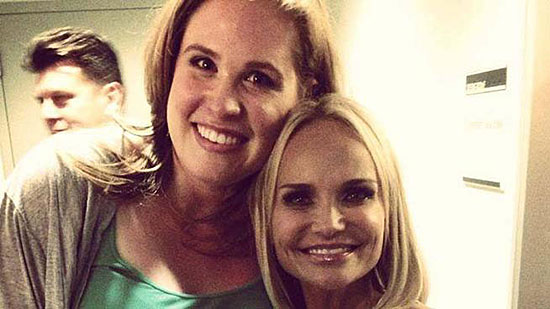
Sarah Horn, left, with Kristin Chenoweth after they shared their "a star is born" moment at the Bowl.
The people who work behind the scenes to produce one memorable concert after another at the Hollywood Bowl every summer might be forgiven for getting a little jaded.
This season alone, they’ve witnessed superstars ranging from Willie Nelson and Diana Ross to Yo-Yo Ma and Itzhak Perlman performing under the stars before tens of thousands of people.
So that makes what happened at the Bowl last Friday all the more remarkable.
A music teacher from Riverside named Sarah Horn, selected from the audience to sing a duet with Kristin Chenoweth, turned in a note-perfect performance of “For Good” from “Wicked” that did more than bring the Bowl audience to its feet. It also knocked the seasoned Bowl staff off theirs.
“All you could hear [backstage] was ‘Wow!’ Other than that, you could have heard a pin drop,” said Paul Geller, production director for the Bowl and the Los Angeles Philharmonic, which leases and operates the county-owned facility.
The Bowl team, along with the concert audience of 9,214, was the first to witness Horn’s performance, in which she harmonized fluidly and effortlessly traded solos with Broadway legend Chenoweth. But they weren’t the last. A friend’s video of their performance, posted to YouTube, had racked up more than 2.2 million hits as of Tuesday afternoon. Her own account of the evening was posted on Broadway World.com and the story has been picked up by media outlets ranging from the Huffington Post to the Hollywood Reporter.
“I was there and it was amazing,” said Chris Ayzoukian, the Philharmonic vice president who oversees the orchestra as well as productions at the Bowl and Disney Hall. “We see a lot of shows. Magic happens a lot at the Hollywood Bowl…but when something special happens, you just feel it in the air.”
As the second half of the concert got underway, Ayzoukian was attending to his usual performance night duties from Box 1041, texting staffers backstage with comments about audio and video quality.
Then Chenoweth selected Horn—who was attending the concert with friends and family—from among fans in the audience vying for a chance to sing onstage with her.
“Sarah sang literally the first note and we were like, ‘Hello. This is serious business,’ ” Ayzoukian recalled.
In short order, he stopped texting the backstage crew about technical issues and started sending messages like: “Wow, someone hire her immediately.”
Horn, of course, was living out a popular fantasy: who hasn’t daydreamed of belting out a show-stopping number before a spellbound audience? Then there was the undeniable tension inherent in the moment: would this unknown blow her big chance, forget the lyrics, sing out of tune?
No, no and no.
“I think part of it is the sense of surprise—this amazing singer who’s among us in the audience. She represented everyone in the audience that day,” Ayzoukian said. “That’s why it was so inspiring.”
(Inspiring, and so good that the questions started almost immediately: was Horn a plant? “Absolutely not,” the Philharmonic says.)
After the show, Geller, the production director, raced into the audience to get the voice teacher’s contact information and invite her backstage.
“Both she and her parents were fairly wide-eyed,” Geller said. “They knew that they were walking backstage at a world-famous venue.”
The crowd of VIPs clustered around Chenoweth’s dressing room—“all pretty high-powered people in the industry,” as Geller put it—gave her a welcome to remember.
“As soon as they saw her, they started chanting, ‘Sarah! Sarah!’ ” Geller said. “It was the most unbelievable experience.”
Geller, who has worked at the Bowl since 1970, has had his share of incredible moments over the years and this one, he said, is going on the list. “It was moving,” he said, “for all of us there.”
Meanwhile, Horn’s return engagement at the Bowl already has been booked. She’ll be serving as a guest judge of ABBA-Capella, a “show-tune-styled sing-off” contest among collegiate groups that is part of the Bowl’s ABBA Fest concert on Sunday, Sept. 8.
Posted 8/28/13
L.A.’s story comes to life
July 10, 2013
Los Angeles is young compared to most American cities. It incorporated in 1850, the same year Levi Strauss began manufacturing jeans. But no one can accuse the nation’s second-largest metropolis of being uneventful, and this weekend, a new permanent exhibit at the Natural History Museum of Los Angeles County will begin counting the reasons.
From missions to movies, ranchos to railroads, “Becoming Los Angeles”—a show almost as sprawling as its subject—will take visitors through 500 years of local evolution, tracing the environmental and cultural shifts that turned Southern California into a 21st century global hub.
The 14,000-square-foot exhibition, which opens to the public on Sunday, will not only be the museum’s largest, but will serve as the finale to a decade-long overhaul of the museum, which celebrates its centennial this year.
“We’re looking at Los Angeles history through the lens of how people and the environment have interacted,” says Margaret Hardin, division chief for anthropology and history at the museum. “That’s our overarching narrative.”
Some of the stories are well known—how water from the Owens Valley allowed Los Angeles to grow in the early 1900s, for example. But others are less-told tales, such as the story of the night a surging L.A. River jumped its banks and changed course, or the tale of the grasshopper plague that helped set the stage for the region’s transformation from agriculture to industry.
Tying the narrative together is a swooping steel architectural canopy that touches down at pivotal points in the history of the region. Underneath, four galleries of cultural artifacts give life to the story: the Mission San Gabriel cross, a stuffed grizzly bear, the antique writing desk of California’s last Mexican governor, the headlight of a Southern Pacific locomotive, a souvenir bottle of water from the 1913 opening of the Aqueduct, Charlie Chaplin’s “Little Tramp” costume, the workstation where Mickey Mouse was born.
Sprinkled throughout are interactive multi-media installations. A scale model of downtown L.A. in the 1930s, for instance, lets visitors time travel through the centuries in ten neighborhoods. A bench near the display on the mission era plays a snippet of devotional music when visitors sit in it.
Another interactive exhibit explains the environmental change that turned the Los Angeles region into an annual fire hazard, where invasive, non-native species edged out native, perennial grasses—a process accelerated through “cow poop,” in the words of the museum. This particular display is aimed at one of the museum’s most faithful audiences—little boys.
“We really had a great time,” says Hardin. “There are all these small delights.”

The Natural History Museum's new exhibit on Los Angeles includes four galleries of cultural artifacts.
Posted 7/10/13
L.A.’s biggest science project ever
June 13, 2013
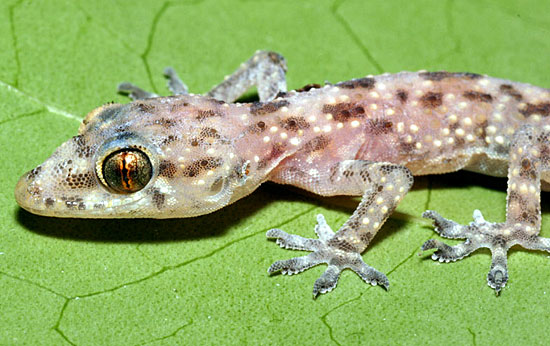
Natural History Museum “citizen science” yielded the first L.A. sighting of this gecko species. Photo/Gary Nafis
When the Natural History Museum of Los Angeles County launched its recent renovation, one of the goals was to make room for more science. Turns out it also made room for more scientists—of the backyard amateur variety, no lab coat required.
With the addition of the new Nature Lab and Nature Gardens as part of its centennial celebration, the museum’s growing involvement in so-called “citizen science” projects has gained new prominence, enlisting Southern Californians by the thousands in projects to catalogue the region’s biodiversity.
From insect counts to inventories of freeway roadkill, the museum has more than a dozen initiatives that are either ongoing or in the works now in which the public is playing a key role in the study of wildlife in Los Angeles County.
“It’s like crowdsourcing, and it can be an amazing resource,” says Lila Higgins, manager of citizen science and live animals at the museum.
Also known as participatory science, citizen science has become increasingly common as technology has made it easier for scientists, professional and amateur, to share observations and collaborate.
“In some ways, it isn’t new,” says Greg Pauly, curator of herpetology at the Natural History Museum, noting that volunteers at the NHM’s Page Museum have been helping process fossils for many years. “But with the Internet and smart phones and other digital devices, anyone can, say, photograph an organism and send it over the net to be included in scientific research. And people of all ages can help that way.”
Worldwide projects, such as the extraterrestrial life site SETI@Home, and the ornithology database eBird, have been reaching out to the public for more than a decade, and the Natural History Museum has been among the local pioneers of the concept. As far back as 1994, for instance, museum ornithologists enlisted the public in a study of feral parrots in Southern California.
The California Parrot Project, which is still ongoing, asked birdwatchers to let the study’s organizers know about local parrot sightings, and eventually yielded one of the first reliable counts of the numbers—upwards of a dozen species—of parrots breeding in the wild here, says Kimball L. Garrett, ornithology collections manager at the museum.
“It was extremely primitive—we’d mail out newsletters,” says Garrett. “But all this research from the mid-1990s gave us a baseline to figure out whether these populations are expanding or contracting now.”
Of the museum’s current batch of citizen science projects, the oldest is the 11-year-old Spider Survey, which asks the public to collect spiders in their homes and gardens, take down some data and bring or send what they find to the museum, Higgins says.
“At the time, it was the cutting-edge thing,” she remembers. “We launched it in 2002 at the museum’s Bug Fair, and the first week, a thousand spiders came in.”
Since then, some 6,000 spiders have been sent into the museum from throughout Los Angeles County; among the project’s findings was the first sighting of a brown widow spider in L.A.
“We’re a port city with people and goods coming and going on a daily basis, and with them, creatures sometimes hitch a ride,” Higgins explains.
Other citizen science projects have yielded even more exciting data. In 2010, Will and Reese Bernstein, a father and son from Porter Ranch, submitted a photo of a tiny reptile they’d seen at a backyard dinner party to the museum’s Lost Lizards of Los Angeles project. The critter turned out to be the first documented discovery of a Mediterranean House Gecko in L.A.
Although the non-native gecko (also known as Hemidactylus turcicus) has been spotted in the southeast United States, the L.A. sighting was so significant that the Herpetological Review plans to publish the finding this fall, says Pauly: “So Reese Bernstein, who is 12 years old now, will already have published a paper in a scientific journal.”
In April, the Lost Lizards project turned up yet another out-of-state reptile, an Indo-Pacific Gecko that was found in a backyard in Torrance. The project has been so successful, in fact, that it’s being expanded to include amphibians.
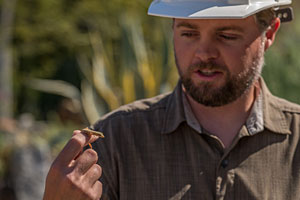
Greg Pauly’s Lost Lizards of Los Angeles project worked so well that it’s expanding. Photo/SoCal Wild
“Maybe you see a turtle at the park, or an alligator lizard in your yard, or maybe a salamander in the Santa Monica Mountains,” says Pauly. “You submit a photograph of it to our project, and that data will be available to scientists for generations to come.”
Coming up will be the citizen science component of Bioscan, a 3-year look at, among other things, the diversity of Los Angeles insects. Project Coordinator Dean Pentcheff is looking for a homeowners willing to host bug traps in their backyards and volunteers willing to sift through the take, sorting beetles from butterflies. A special side project in August will count bugs drawn to porchlights.
“We’re about three months in,” says Pentcheff, “and already we’ve found new species unknown to science.”
Pauly, the herpetologist, says such projects are especially important in places like Los Angeles County because the interface between the wilderness and the expanding urban landscape is on the cutting-edge of science these days.
“When you ask people here where they go to see nature, they say things like, ‘Sequoia’ or ‘Anza Borrego.’ But we’re surrounded by incredible diversity, and you don’t even have to leave L.A.”
Posted 6/13/13
LACMA lights up
May 30, 2013
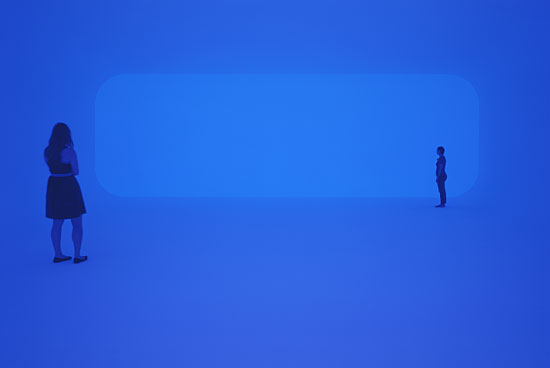
James Turrell's stunnng "Breathing Light" is part his new LACMA retrospective. Photos by Florian Holzherr
When Denver art dealer Adam Gildar heard about the James Turrell retrospective at the Los Angeles County Museum of Art, he went straight to the museum’s website for advance tickets to the widely anticipated show. Bound for L.A. with some collectors during the July 4 weekend, Gildar was particularly hoping to see “Light Reignfall,” a mind-blowing, one-person-at-a-time Turrell light show in a spherical tank that looks like something out of a sci-fi movie.
Unfortunately for him, so, apparently, is just about everyone else.
The Turrell show—packed since its opening last week, with “Light Reignfall” reservations sold out until late August—is shaping up to be one of this summer’s hottest tickets, and not just at LACMA.
On June 9, the Museum of Fine Arts, Houston, will showcase a cross-section of large and small works from its collection by the pioneering, Los Angeles-born artist. In New York, starting June 21, the rotunda of the Guggenheim Museum will be turned into a gigantic Turrell light piece.
Over on La Brea Boulevard, Turrell’s gallery, Kayne Griffin Cocoran, last week opened a new space designed by the artist, with a show tracing the 37-year history of his still-incomplete magnum opus, “Roden Crater.” The new gallery also has a signature Turrell “skyspace,” a part-skylight, part-lightshow creation that has become the new must-have architectural feature for art lovers. More than 80 have been installed worldwide, mostly for private collectors, including at least a half-dozen in homes and galleries in Los Angeles County.
“It is sort of a festival of James Turrell,” says LACMA Director Michael Govan, who co-curated the LACMA show and whose relationship with the white-bearded artist dates back to Govan’s last job at the Dia Art Foundation in New York.
And, Govan adds, the festival will be a long-running one.
Turrell’s medium is light, colored and natural, manipulated in ways that are designed to engulf and disorient the viewer. But because many of his artworks are built so that only a limited number of people can experience them at once, LACMA is expecting crowds to move much more slowly than usual through the exhibition.
“Tickets to that show are like Stones tickets,” an artist’s liaison for a large L.A. gallery confided earlier this week. “Everybody wants in.”
As a result, the museum is selling timed tickets, both to the retrospective and to high-demand pieces such as “Light Reignfall,” and extending the show for almost a year so that anyone who wants to can eventually see it. The exhibit also will stay open until 11 p.m. on Fridays from July 5 to August 30 as part of extended summer hours at LACMA’s Resnick Pavilion and the Broad Contemporary Art Museum.
For some, the thrill is in seeing the artist’s work on its home turf. Now 70, Turrell pioneered Southern California’s Light and Space Movement and made his name in L.A.
Others are looking forward to literally immersing themselves in the pieces.
At a press preview this week, a woman—helped by a pair of attendants in white lab coats—emerged from “Light Reignfall” dazed and comparing the experience to the aura from a somehow-painless migraine. Meanwhile, crowds of donors and arts writers stood in line for up to an hour for a chance to take off their shoes and climb a black-carpeted pyramid into “Breathing Light,” a 5,000-square-foot installation that creates the sensation of being suspended in a fog of luminosity.
Still others are curious about “Roden Crater,” the massive installation and “naked-eye observatory” that Turrell has been building for decades in a volcanic crater near Flagstaff, Az.
“There was a time when I was kind of worried about my career, like many mid-career artists, and thinking maybe I was going nowhere,” the artist chuckled at Wednesday’s press conference. “Now if you find yourself in the middle of nowhere, you’re probably somewhat near my work.”
Turrell jokingly compared the crater installation to an unfinished doctoral thesis, and kidded that he was raising money for its completion by “selling blue sky and colored air.” More seriously, he said this summer’s exhibition of his work has drawn attention to the multi-million-dollar project. And, he noted, his skyspace commissions not only have helped underwrite his larger work, but also have informed it, capturing light in its infinite variety.
“I remember when we had backyard burning in Pasadena, and tremendous smog here, but it’s a special, soft, beautiful sky we have here now,” he said. “Arizona has a crisp, clear, hard sky. Each of these places is different, city and country, and I like to celebrate all the different kinds of skies.”
Back under the Denver sky, Gildar the art dealer is looking forward to the retrospective, with or without “Light Reignfall.” It is, after all, the largest-ever survey of the artist’s work and the first in nearly 30 years.
And a fan can hope. Shut out at LACMA’s web site, he ran an ad offering $20 over the ticket price on Craigslist to anyone willing to sell their 12 minutes of Turrell immersion. “But it doesn’t look like there’s much of a possibility that that’s going to work out,” he says, “and that’s okay. It’ll be amazing to see any of his work.”
Posted 5/29/13
Puppets come out to play in L.A.
April 4, 2013
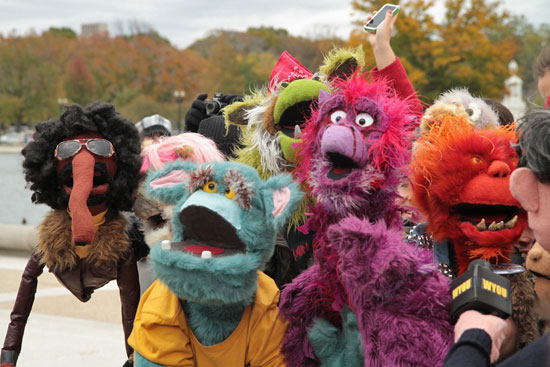
The "Million Puppet March" in Washington had a goal of saving PBS funding. Only fun is on the agenda for L.A. Puppet Fest.
Stretching their wooden arms, the sleeping puppets of Los Angeles are ready to take center stage.
The puppetry community is full of characters—and not just the wooden or fuzzy varieties. From old-school marionettists to modern dramatists who manipulate 10-foot monstrosities in teams of three, they’re as diverse as the city they live in.
Last September, Joe Smoke of the City of Los Angeles Department of Cultural Affairs approached Maria Bodmann, an expert in the thousand-year-old art of Balinese shadow puppetry. Together, they pulled a few strings and organized a meeting of L.A. puppeteers with the goal of producing a citywide festival. This month, their plans will come to life at the inaugural L.A. Puppet Fest.
Bodmann hopes the festival will expose people to the many varieties of puppetry.
“People think fuzzy things with eyeballs, but that’s just one little bit of puppetry,” Bodmann said. “There are other types that address issues that aren’t really for kids. The stuff I do is connected to religious rituals. I can’t really do it for birthday parties.”
Pre-festival activities have already begun. From Thursday through Saturday, Rogue Theaters presents “Songs of Bilitis,” a mature audiences-only puppet rendition of the French erotic novel by Pierre Louÿs. The official opening takes place Sunday, April 7, at the Skirball Cultural Center and will feature puppet-making, performances and storytelling. After that, there will be performances by the Bob Baker Marionette Theater, a lecture on puppet history and puppet films and classes. The festival wraps up on April 28 with “L.A.’s largest-ever puppet parade” and closing ceremony at the Third Street Promenade in Santa Monica. See the website for a full schedule of events.
Michael Earl, a co-founder of the Puppet School who had a turn playing “Mr. Snuffleupagus” on Sesame Street a few decades back, said professional puppeteers have been through tough times in recent years.
“When Jim Henson was alive, there was a lot of puppetry happening; they had to train more puppeteers because there were not enough,” Earl said. “Then, 3D animation was invented and it slowly started to replace puppetry jobs.”
But Earl and his contemporaries see puppets making a comeback, due partly to the success of live stage productions like The Lion King and popular box office offerings including Where the Wild Things Are and 2011’s The Muppets.
Cue the L.A. Puppet Fest, which is being called L.A.’s first-ever citywide puppet festival—a description reached amid controversy.
“There is inter-puppet genre conflict,” said Michael Bellavia, who is organizing the puppet parade and closing ceremony. “The puppet geeks, they got all up in arms when this was billed as the first puppet festival.”
Accounts vary. Some point out smaller-scale annual events by the Los Angeles Guild of Puppetry. Alan Cook, co-founder of the guild and curator of the International Puppetry Museum in Pasadena, is a revered patriarch of the puppetry community. He recalls a major, national festival held at UCLA back in 1957. Recorded puppet history in Los Angeles dates back at least 100 years, he said. Worldwide, forms of puppetry go back millennia and represent some of the most respected cultural art forms.
The guild’s current president, Christine Papalexis, said contention among puppeteers is common because they’re artists.
Despite their differences on the minutiae, everyone agrees the festival should be as inclusive as possible. They’re united by a love of puppetry that, for many, began with their first toy puppet in early childhood.
That inclusivity extends to the audience, who will be invited to make their own puppets and learn puppetry skills at some of the events. The L.A. Puppet Fest Parade, for example, will have a puppet-making station on site, and organizers say it’s fine if people just want to draw eyes and a mouth on their hands.
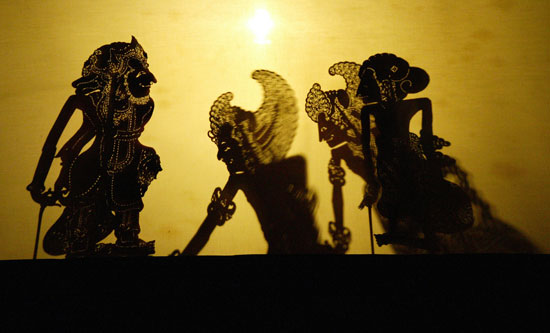
Carved rawhide shadow puppets act out a scene involving the heroic Pandawa brothers of the Mahabharata, a Sanskrit epic from ancient India.
Posted 4/4/13
A legend lives on, with library’s help
March 21, 2013
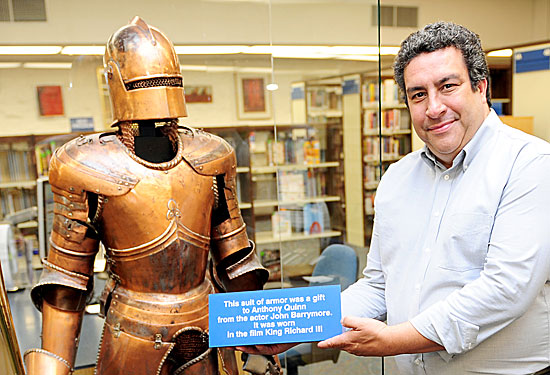
Heavy metal: the suit John Barrymore wore in "Richard III" is just one of the Anthony Quinn Collection's treasures.
There’s the suit of armor his mentor, John Barrymore, gave him. There’s the cap, now bronzed, that he wore in “Zorba the Greek.”
When Anthony Quinn left his papers to the East L.A. library on the site of the house where he spent part of his boyhood, the late actor defined the bequest broadly; there are movie stills, letters, handbills, art works, even a couple of Oscar nominations.
Less comprehensive was the plan to preserve the collection for posterity.
“Most of this came to us in boxes, which we changed to County Library boxes,” says Chicano Resource Center Librarian Daniel Hernandez, who oversees the Anthony Quinn Collection, a trove of some 2,000 items of personal and show business memorabilia that the artist gave to the county library more than 25 years ago.
The collection is a historical gem, offering a wide-ranging view of Quinn’s East Los Angeles roots and his life as a self-made man and 20th century film star, but its preservation has been a concern since Quinn made the donation in 1987, says Hernandez.
A few pieces—the suit of armor, the Zorba cap—have been used as library displays and a few others have been loaned to other museums for exhibits on show business or Latin culture. Most, however, have spent the past couple of decades in storage, he says, and the cardboard library boxes, while an improvement over the original containers, have hardly been a long-term solution.
“Everything has been safe,” says Hernandez, gesturing to a wall of cabinets, stacked floor to ceiling, in a locked room at the Anthony Quinn Library. “But even though it’s OK for right now, it’s not OK for the future to come.”
So this week, the Los Angeles County Board of Supervisors accepted a $6,000 grant from the National Endowment for the Humanities to help preserve the cache, from film scripts and taped interviews to thank you notes and birthday cards. The funding will, among other things, underwrite an assessment from a professional conservator and pay for appropriate preservation supplies and containers.
“There’s not that much knowledge of this collection,” says Hernandez, flipping through a draft of one of Quinn’s two autobiographies, typed and annotated on fragile onionskin paper. Next to it sat a cardboard box filled with gilt-framed black-and-white photos—Quinn as a young actor, Quinn in Italy, Quinn with his “Zorba” co-star Melina Mercouri.
“People are aware it’s out there but they don’t know what’s in it. One of our goals is to get that out into the public consciousness.”
Born in 1915 in the Mexican state of Chihuahua, Quinn—who inherited his surname from his part-Irish father, Francisco—came into the U.S. as an infant with his parents, who were migrant farm workers for several years before settling in Los Angeles. Here, Quinn’s father found work as a studio property man and the family moved into a house at the corner of Hazard and Brooklyn (now Cesar Chavez) avenues in East Los Angeles.
“I can’t tell you what an emotional thing it is to be standing on the spot my cousin beat the hell out of me,” Quinn joked to the Los Angeles Times in 1983, when the site—long since razed to make way for the county’s Belvedere Library—was renamed in his honor. In a more somber moment, the actor also said that when he was 9, his father had been killed in an automobile accident near the same corner.
Photos in the collection commemorate Quinn’s youth as a student at Belvedere Junior High School and Polytechnic High School, where he took courses in art and architecture, but, according to obituaries, never earned a degree.
After stints in Los Angeles as a boxer, a musician and even an evangelical preacher, Quinn tried acting. In 1936, he debuted in a cameo role in the film “Parole” and in a stage role that had been written for John Barrymore, a much older and more famous actor.
Among the papers in the collection is an account of his friendship with Barrymore, who took him on as a protégé after seeing the performance, and later gave him a suit of armor he had worn in Richard III, comparing it to the sword a retiring bullfighter hands down to “his preferred novillero.”
The suit—the largest item in the collection—is on display in the reading room of the branch library that now stands on the site of Quinn’s old homestead.
Quinn went on to act in more than 100 movies, working well into his 80s and winning two Oscars for best supporting actor—first as the brother of the Mexican revolutionary Emiliano Zapata in “Viva Zapata!” and later as the artist Paul Gauguin in “Lust for Life”.
As his fame grew, he spent more of his time in Italy and New York than on the West Coast, but he maintained his local connections.
“He never forgot his people,” the sister of one of the defendants in the famous 1942 “Zoot Suit” murder trial told the Los Angeles Times at the 1983 library dedication, noting that Quinn—married by the time of the historic trial to the director C.B. DeMille’s daughter—had gone out on a limb both politically and professionally to help raise money for the appeal.
“He’s still pretty much of a local hero,” says Hernandez. “He’s an example of how you can work your way up and always care for your community. People here all seem to remember his aunt, or to have gone to school with him, so it’s a big social goal for us to save his works and preserve them.”
Quinn died in a Boston hospital in 2001 of respiratory failure. “But here in the community,” Hernandez says, “he’s very alive.”
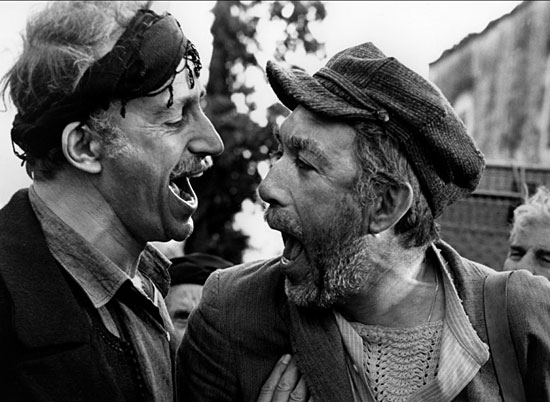
Quinn won two best supporting actor Oscars, and was nominated for his star turn in "Zorba the Greek."
Posted 3/21/13
Meet L.A.’s oldest meteoric stars
February 22, 2013
Last week’s Russian meteor strike may have been astonishing (not to mention hazardous to thousands of Siberians), but great balls of fire can land anywhere—even in greater Los Angeles.
Take the 30-pound Neenach meteorite—4.5 billion years old, give or take a few hundred million—that was turned up by a plow in 1948 by an Antelope Valley rancher. Or the 42-pound Littlerock meteorite, found on a farm in 1979 near Palmdale.
There are even a pair of rare Martian meteorites named for Los Angeles County, though technically the collector who discovered them said he can’t recall precisely where in the Mojave Desert he stumbled across them; the two lava chunks, weighing about a pound and a half-pound, respectively, languished for nearly two decades in a box of loose rocks at his home in Sunland, until he took them in 1999 to UCLA for testing.
Now, a thin slice of “Los Angeles 002,” as the smaller meteorite is now known, is behind glass at the Natural History Museum of Los Angeles County, along with the other aforementioned local examples of primordial stardust.
“Meteorites are hitting the Earth constantly,” notes Alyssa R. Morgan, collections manager in the gems and minerals department of the Natural History Museum.
“Most of them are as tiny as dust or sand grains, but they make the Earth bigger every day.”
Like geologists the world over, Morgan’s mind has been on last Friday’s extraterrestrial fly-by as the museum has braced for Los Angeles’ usual response to meteor-related publicity. The meteorite, which is estimated to have been 55 feet in diameter, rained black and brown fragments for miles across the snow as it streaked across the Ural Mountains, shattering windows and injuring some 1,200 people. Though the bulk of it has yet to be recovered, it is believed to be the largest such object to have hurtled to Earth in more than 100 years.
“Usually after a newsworthy event like the one in Russia, we get lots of calls from people saying, ‘You know, I found this funky rock a while ago and I’ve been meaning to have it tested’,” says Morgan, who has been fascinated by meteorites since her childhood in Seattle, and who studied moon rocks as a graduate student at Brown University. “Ninety-nine times out of 100, they’re not meteorites.
“We have had some real ones come in, though. Last year, a guy who buys storage lockers at auctions brought in a box of rocks so carefully wrapped that he figured the person he’d bought them from had to have been a collector. It turned out he was right, although we never did hear what he decided to do with them.”
Meteorites are meteors—typically asteroids or fragments of asteroids, moons or planets—that have made it through the Earth’s atmosphere and landed.
Some meteorites, Morgan says, are remnants of planets shattered long ago in collisions; others are chunks of existing planets and moons that were chipped at extreme velocity by other meteorites.
No meteorite is believed to have ever killed a human being, though they’ve reportedly landed several times on houses, workplaces and, in at least one verified instance, a doctor’s office in Virginia. In 1911, the famous Nakhla meteorite allegedly killed a dog in Egypt (though that’s been disputed.)
But all meteorites, she says, are time capsules.
“They’re primitive pieces of what everything in our solar system, including our sun, is made of,” says Morgan. “That’s part of why meteorites give us tremendous insight.”
The Natural History Museum’s meteorite collection is modest compared to those, say, at the Smithsonian Institution or the research collection at the Institute of Geophysics and Planetary Physics at UCLA.
Morgan says the NHM collection currently has about 50 specimens. One, a piece of the Argentine Campo del Cielo meteorite, was purchased especially for the new Dinosaur Hall to help illustrate the ongoing debate over whether climate change or a catastrophic meteor strike cleared the way for the age of mammals.
But the most notable other specimens are on display in the museum’s Gem and Mineral Hall. They range from a coin-sized sliver of a rare lunar meteorite found in Libya in the late 1990s to a good-sized hunk of the Canyon Diablo meteorite, which fell in Arizona some 50,000 years ago, creating a massive crater. The latter was instrumental in the determination—by Caltech geochemist Clair Patterson in the 1950s—that the Earth is about 4.55 billion years old.
“Before that work, people knew the Earth was old, but had no way to calculate its age,” says Morgan, running her hand along the big, dark meteorite’s dented surface. “Through this rock, we learned something we now take for granted—how old we are.”
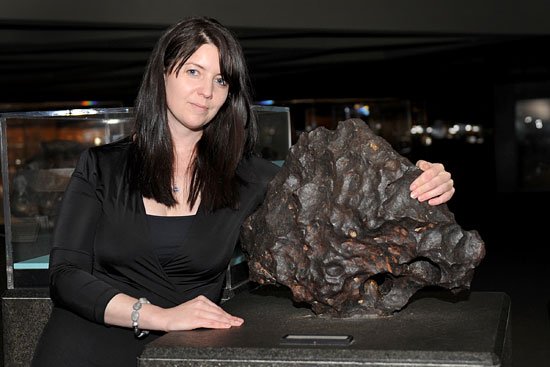
Alyssa Morgan with a chunk of the Canyon Diablo meteorite, which helped scientists determine the Earth
Posted 2/22/13
Kubrick’s a hot ticket for hipsters
December 12, 2012
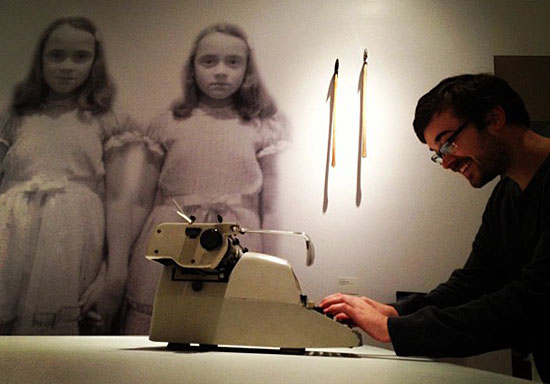
Enthusiastic patrons are sharing their Kubrick exhibition photos on social media. Instagram photo/natalie_matti
The average LACMA visitor this year was well over age 40, but the crowd at the museum’s new Stanley Kubrick exhibition has been looking more like the baby at the end of “2001: A Space Odyssey.”
Twenty minutes before closing on a recent Monday, the rooms were swarming with patrons young enough to be the late director’s grandkids. Here was 17-year-old David Feinziner, in from La Mirada with his parents; there was 23-year-old aspiring producer Kelsey Baca, checking out the great man’s typewriter with her 28-year-old aspiring director boyfriend, Ian Lewis. There was Alexandria Sivak, 28, who works in communications at the Getty, back for the second time since the show’s preview. There was goateed Ben Lee, a 32-year-old musician, whose friend had heard about the show online and alerted him from South Korea.
“Just to be able to see Kubrick’s notes and his vision and his process, and to see the creativity behind the film is just so cool,” marveled Leah Yananton, a 32-year-old filmmaker in a magenta knit trapper hat who had come with a New York friend who had caught the buzz from a twentysomething on Facebook.
“I plan on coming again at least once more before the show is over,” Yananton said, modestly noting that she, too, has an upcoming movie project: “It’s a coming-of-age film in post-production called ‘Surviving Me’.”
Museum officials say it’s too soon to know how the Kubrick show’s demographics will shake out; some 47,000 visitors have seen it so far, but the exhibition, which opened November 1, has only been running about six weeks and won’t close until the end of June.
However, Brooke Fruchtman, associate vice president of public engagement at LACMA, said all signs are that the show is appealing to the same kind of crowd that mobbed last year’s Tim Burton exhibition. That show, which drew more than 363,000 visitors, many in costume, had an audience with an average age of 33, eight years younger than the average visitor that fiscal year to the museum.
“Our Kubrick app is on track to be LACMA’s most downloaded app ever,” she said. “In the first week alone, we had 6,517 downloads.” Meanwhile, pickup on social media “has been huge for Kubrick, with Twitter, Instagram and Tumblr being flooded with images from the exhibition.”
Fruchtman said that, aside from an innovative series of Kubrick-themed pop-up dinners, the marketing of the show has been about the same as for prior ticketed exhibitions. Still, she added: “Sometimes it resonates more than others, depending on the show. “
“Oh yeah, it’s a younger crowd—and they’re all into it, too,” chuckled gallery attendant Rickie Williams on Monday. “They’ve been taking lots of pictures, compared to the older people who come in during the week, who are more often other directors or people who were in the crew or acted in his movies.” (Show business people turned out in force for the show’s opening gala, and star sightings in the crowd since then have included Ben Stiller, who tweeted his admiration from the show, Ryan O’Neal, who starred in “Barry Lyndon,” and “Full Metal Jacket’s” Vincent D’Onofrio.
“I think it’s just that his work is timeless,” said Lewis, the young director, who had taken a break from the cooking show that employs him, and who, with his young friend, Baca, was among the last to leave. “Look!” she breathed on their way out. “There’s his director’s chair!”
Lee, the musician, said the draw for him was “Barry Lyndon.” “It’s my favorite film—it’s so lyrical and touching. I’ve watched that movie more than ten times and I still find something new.”
To Feinziner, the high school senior, the show was a glimpse at a possible future: “I’ve applied to Chapman University, USC and UCLA,” he confided. “I’m planning to go to film school next year.”
Whatever the motivation, Fruchtman welcomes the youthful cohort, which the museum has sought to attract with free “NexGen” membership for people under 18, student discounts, school programs, a hip hop series, teen dances and other youth-oriented programs and events.
But, as any 21st century Los Angeles kid can attest, a thing either captures the imagination or it doesn’t, and so far, it appears that the Kubrick show has broadened the demographic. That’s good news for LACMA.
“Bringing in a younger—and generally more diverse—audience,” Fruchtman said, “is extremely important to us.”
Posted 12/12/12
Happy finale for opera loan
December 5, 2012
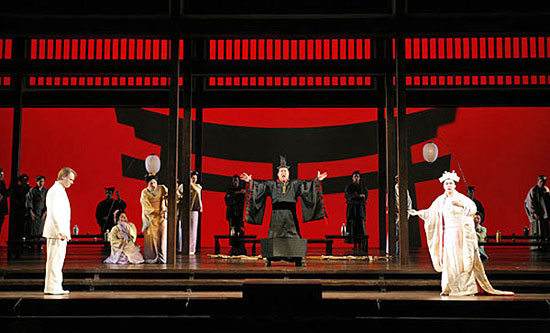
Things are looking up for LA Opera, which just repaid a county-backed $14 million loan. Photo/Robert Millard
Talk about ending on a high note. LA Opera announced this week that it has fully repaid a $14 million loan that the county had guaranteed in 2009 in order to help the company through a financial crisis.
The loan’s final payment was announced by LA Opera’s general director Plácido Domingo. Nearly a year ago, Domingo appeared before the Board of Supervisors to thank them for guaranteeing the loan, from Banc of America, and to announce that the company had repaid the first half of the loan early.
On Wednesday, he announced that the payback was complete. “This is a direct testament to the generosity of our donors and the dedication of our ticket buyers,” Domingo said in a statement. “Thanks to their support and commitment to LA Opera, we will continue to grow and thrive. I am profoundly grateful to the Board of Supervisors for their longstanding trust and confidence in LA Opera, and for recognizing the important and prestigious role that a world-class opera company plays in the greater Los Angeles community.”
Christopher Koelsch, the opera’s president and chief executive officer, echoed that thanks, calling the supervisors’ action “an amazing leap of faith when one of their assets was in trouble.”
The opera was about to unveil an ambitious and long-planned staging of Wagner’s Ring Cycle just as the great recession hit—creating a “perfect storm” of fiscal strains that made the bridge loan necessary, Koelsch said.
While there are still challenges ahead, the outlook now is brighter, Koelsch said, noting that ticket sales revenues are $1 million ahead of where they were last year at this time, with a 21% increase in single-ticket sales and subscriptions up 8% to 10%.
The final performances of the current production, Madame Butterfly, are playing to sold out crowds (the opera ends with a matinee on Sunday, December 9.) But enthusiasts and passersby alike can enjoy two free holiday-themed Songs of the Season recital performances in Grand Park on Tuesday, December 11. The Opera’s also bringing its program to local hospitals and to two Salvation Army residences. (Details of the free performances are here.)
Meanwhile, Koelsch said the company, which will announce the lineup for its next season on January 8, is planning to ramp up its programming gradually as the economy improves.
Paying off the loan, he said, “is a wonderful opportunity for us…it allows us to build toward the future.”
Posted 12/5/12




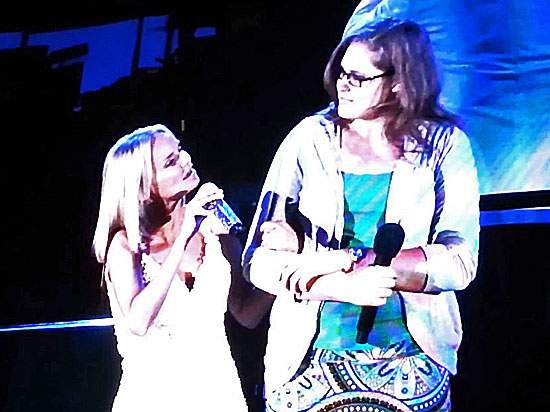

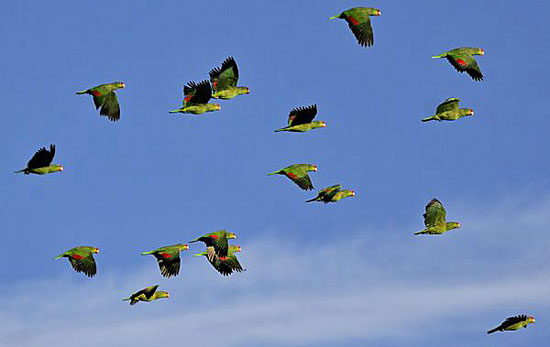
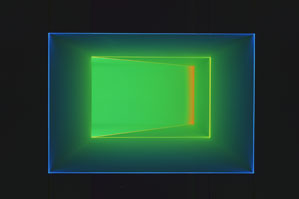
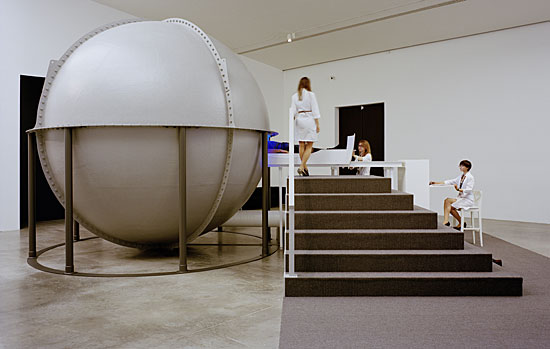
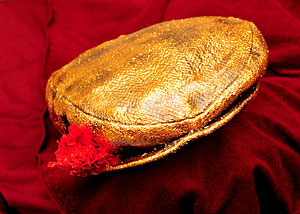
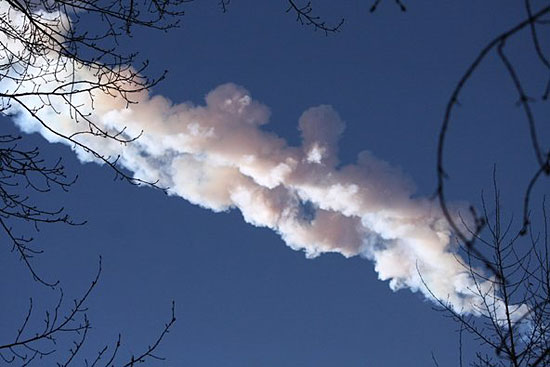
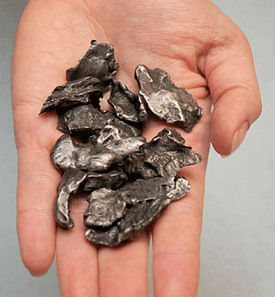
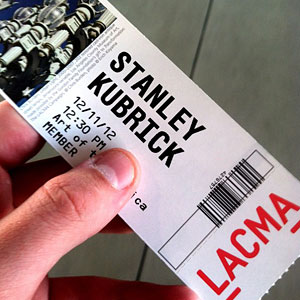
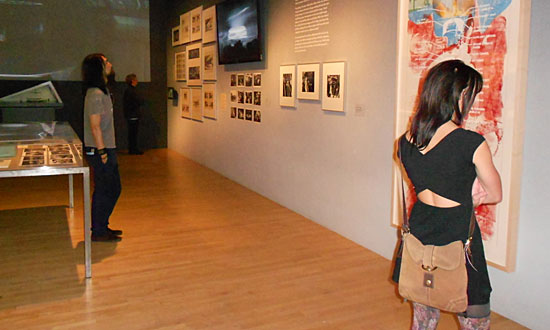









 405 bridge work causes a stink
405 bridge work causes a stink